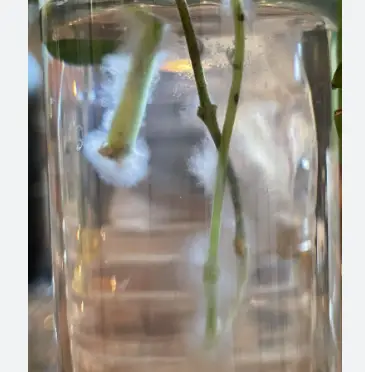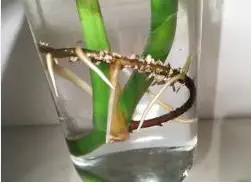While water propagating your plants it is more likely to see white stuff on the roots after some days. Those white stuff can have both positive and negative impacts on your roots.
So, what does it mean when you see water propagation white stuff on roots?
Water propagating White Stuff could indicate new root growth, mineral accumulation, or even fungal/mold growth. The white stuff on the roots can be a normal part of healthy root development, such as the formation of root hairs or callus tissue. Doing Proper care such as providing adequate lighting, and changing the water can help you to have mold and fungus-free roots.
There are many other aspects that you need to know to do proper water propagation without having white stuff. To know more about this white stuff go through the whole article.
What Does Water Propagating White Stuff on Roots Mean?
The appearance of white substance on the roots while water propagating can have various interpretations depending on the context. Here are some possible explanations:
- New Root Growth: When plants are propagated in water, it is common for new roots to develop, which may appear white or translucent.
- Mineral Accumulation: Tap water often contains minerals that can accumulate on the roots over time. It can result in a white crust or buildup. While generally not harmful to the plant, it can be visually unappealing. Also, when plant roots are injured or pruned, callus tissue forms as a part of the plant’s self-repair mechanism. It also can be formed in white color.
- Fungal or Mold Growth: If the white substance is fuzzy, slimy, or cloudy, it could indicate the presence of fungi or mold. These can lead to root rot and damage the plant’s health.

It is necessary to identify the cause of the white substance on the roots to determine the appropriate action. If it is due to new root growth or mineral accumulation, there is typically no cause for concern. However, if it is a result of fungal or mold growth, you need to take steps to avoid root rot.
Explanation of Why the White Stuff Forms.
During the process of propagating plants, it is not uncommon to observe the occurrence of white fuzzy roots or the formation of a white substance in the root area. Here are a couple of possible explanations for these phenomena:
Healthy Root Development and Root Hairs:
When plant roots have ample access to oxygen, they undergo a healthy and robust development. As part of this process, tiny fuzzy structures called root hairs may emerge.
Root hairs are microscopic, elongated extensions of the root surface, and their presence indicates that the roots are functioning well. It also helps on efficiently absorbing water and nutrients from the surrounding environment. However, you can water propagate horehound cuttings and then transplant them as horehounds are known as companion plants.
Callus Formation:
When propagating plants through stem cuttings, you can notice the development of white tissue at the base of the cutting. This tissue resembles a cauliflower floret and is referred to as a callus. Callus formation is a natural response of the plant to injury or stress.

It acts as a protective layer and aids in the healing process. Over time, callus tissue can differentiate into new roots or shoots, leading to successful propagation.
In summary, the appearance of white fuzzy roots or the presence of white callus tissue can be indicative of healthy root development. It basically, includes the formation of root hairs, as well as the plant’s regenerative
How to Care for Plants with White Roots
While water propagates your plant it is possible to notice white stuff on the root. It can be root hair or mold. If the object is slimy and spiderweb-like structure then it is mold. But if your root is mature then there’s a 99.99% chance of getting root hair.
Here are some tips on caring for plants in water propagation and addressing the appearance of white fuzzy stuff:
- Identify the Root Node:
When taking cuttings for water propagation, look for the root node on the main plant. Although not all cuttings have root nodes, most of them do, and this is where roots are more likely to develop.
- Provide Bright Indirect Light:
Place your rooting plants in an area with sufficient bright indirect light. Most common house plants can be propagated using the water method and benefit from adequate lighting conditions. You can also try cypress vine and cardinal climber cuttings for water propagation but it will need proper sunlight.
- Change the Water Regularly:
To prevent the growth of bacteria and mold, change the water every few days. When changing the water, rinse the roots with a gentle rub to remove any mucky film that may have accumulated. You can water propagate syngonium plants also but if you do not change water regularly then your syngonium leaves can not unfurl properly.
- Dealing with White Fuzzy Stuff (mold):
If white fuzzy stuff appears on the plant, it is likely mold. In such cases, you can remove the cutting from the water first. Then wash the glass with hot water and soap, rinse it with alcohol, and then refilling with clean water.
Alternatively, you can transition the cutting into a proper soil mix, removing it from the water entirely. Remember that white stuff on the stems is a normal response to water rooting, so it’s generally best to leave it undisturbed.
- Be Patient and Transplant When Ready:
Rooting can take weeks to months, depending on the plant. Once the roots reach a length of approximately 3 to 5 inches, it’s a good time to transplant the cutting into the soil for further growth.
By following these tips, you can provide proper care for your plants in water propagation. Also, you can minimize the occurrence of white fuzzy stuff or mold.
Plants that Have Fuzzy Roots
Fuzzy roots in plants are generally considered a positive sign of good health and well-being. The presence of white, hair-like structures on the roots indicates that the plant has access to an ample supply of oxygen and nutrients, supporting its overall vitality.
Plants with fuzzy roots can be commonly found among both house plants and commercial plants. Here are some examples of plants that often exhibit fuzzy roots:
| House Plants | Commercial Plants |
| Monstera | Epipremnum |
| Pothos | Ferns |
| Philodendron | Monsteras |
| Ficus | Alocasias |
| Microgreens | Syngoniums |
However, it’s important to monitor the condition of the roots. If the roots become dark, mushy, or exhibit signs of decay, it could be an indication of root rot. And if you get slimy textures then it could be mold or fungus. In such cases, appropriate measures should be taken for the plant’s health.
Frequently Asked Questions (FAQs):
How Long Do You Propagate in Water?
The process of water propagating roots typically takes around 3-4 weeks for many plant species. It is recommended to wait until the roots have reached a length of 1-2 inches or longer before potting up the cutting.
Why Do We Propagate in Water?
Using water for plant propagation is a way to observe root growth, but it’s important to transfer the plant to the soil. Though the success of propagation is not guaranteed. But the use of water for rooting hormone can greatly enhance the chances of successful rooting.
Do Cuttings Grow Faster in Water?
Yes, cuttings grow faster in water. Plant cuttings can exhibit faster root development when placed in water compared to other propagation methods. If you have slow-to-grow cuttings, such as Pothos cutting try water propagation. As it can potentially speed up root development for those plants as well.
Conclusion
Now you know what are the water propagation white stuff on root. During water propagation, it is not uncommon to encounter the occurrence of white stuff on the roots. Regular monitoring, proper care, and adjustments in water quality can help ensure the health and success of plants undergoing water propagation.
- Why Are There Still No Tomatoes in My Tomato Plants? Let’s Fix the Issue! - July 13, 2023
- Water Propagation White Stuff on Roots: Everything You Should Know! - July 11, 2023
- String of Dolphins Drying Up: Solved! - July 11, 2023
